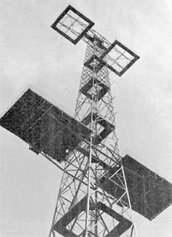Radar Recollections - A Bournemouth University / CHiDE / HLF project
Why Worth Matravers - Achievements at Worth |
|||||||||
|
The period from May 1940 to March 1942 was arguably the most fertile period in the quest to produce airborne radar that could be employed for offensive purposes. TRE Worth (and the associated Leeson House) were after all, primarily Research establishments although operational CH and CHL work was also carried out there. It was also the period when Britain was under severe duress; the
evacuation of Dunkirk, the Battle of Britain, the Blitz and the
Battle of the Atlantic tested the nation's resolve to the limit. New aerial designs
for both ground, airborne and shipborne uses were developed at this
time. Perhaps the greatest step forward came in July 1940 when the
first prototype Magnetron arrived. With this invention it was possible
for Bowen's centimetric team to forge ahead with more effective
and accurate Airborne Interception (AI) equipment. In August 1940,
the team produced the first 10 cm echo from a building: the old
chapel at St Aldhelm's Head. |
|||||||||
|
|
||||||||
|
|
|||||||||
| |
|
Professor
|
|
W. E. Burcham
|
|
Mr
|
|
A. E. Bennett
|
|
Mr
|
|
H. G. Hinkly
|

